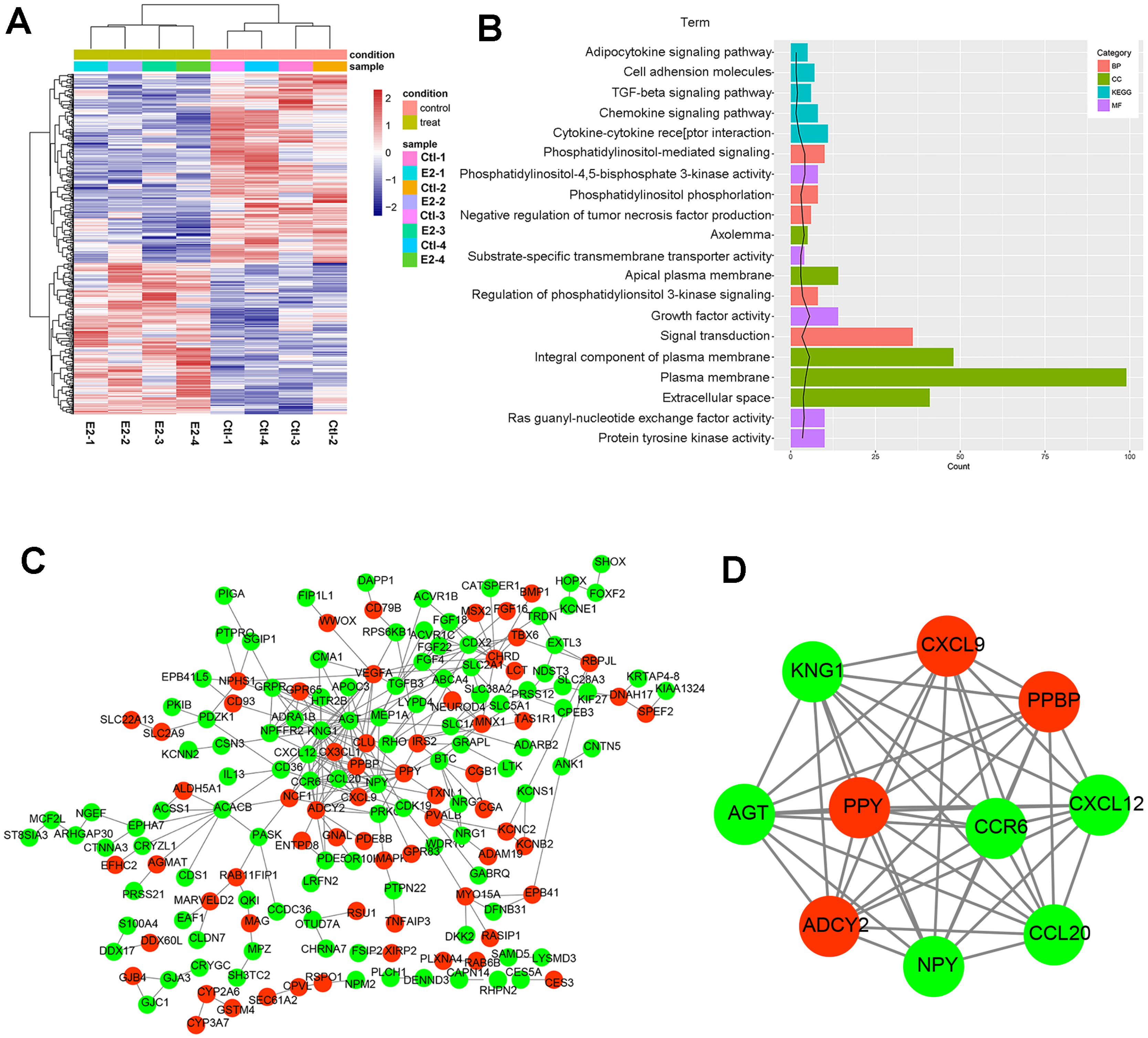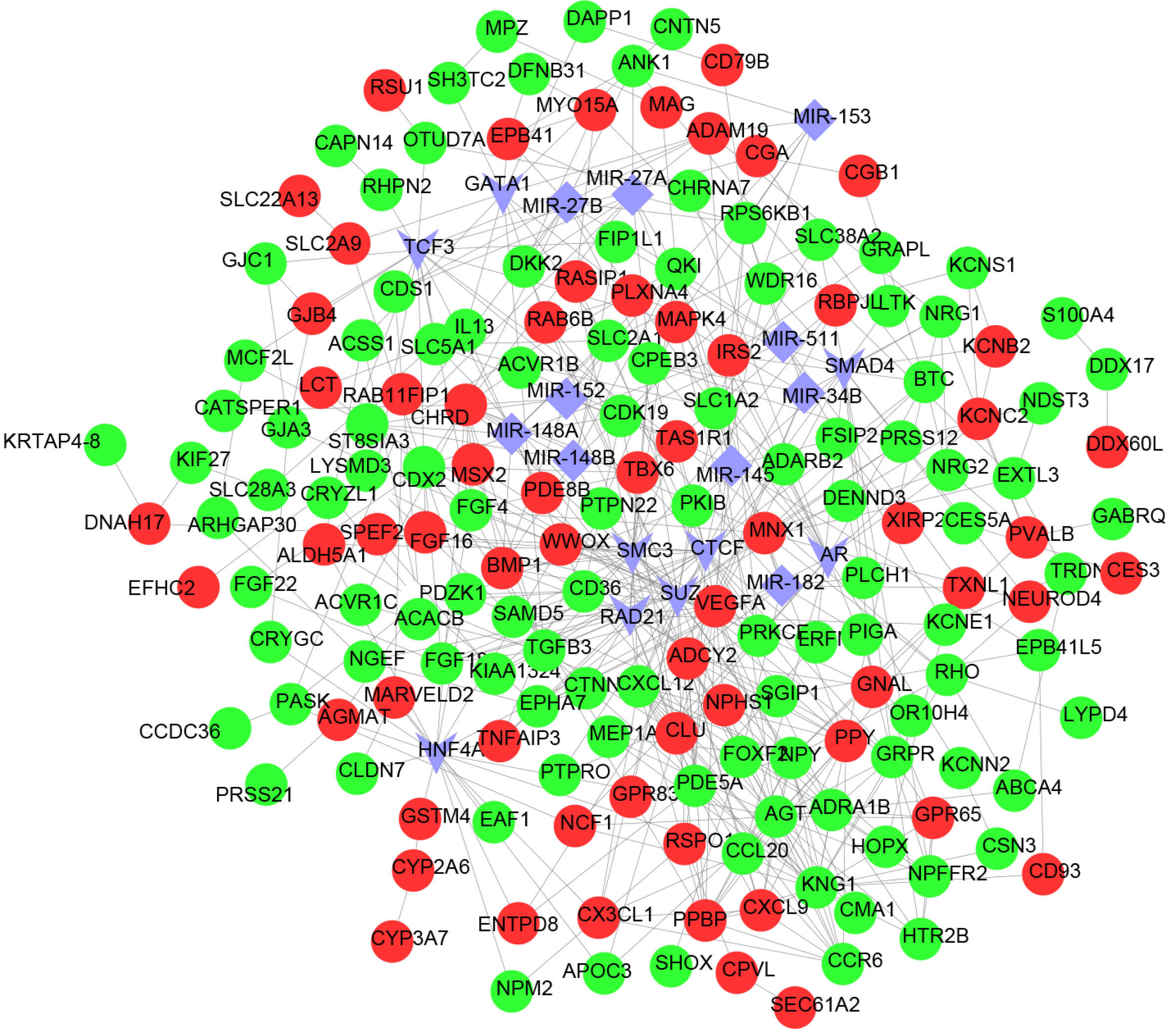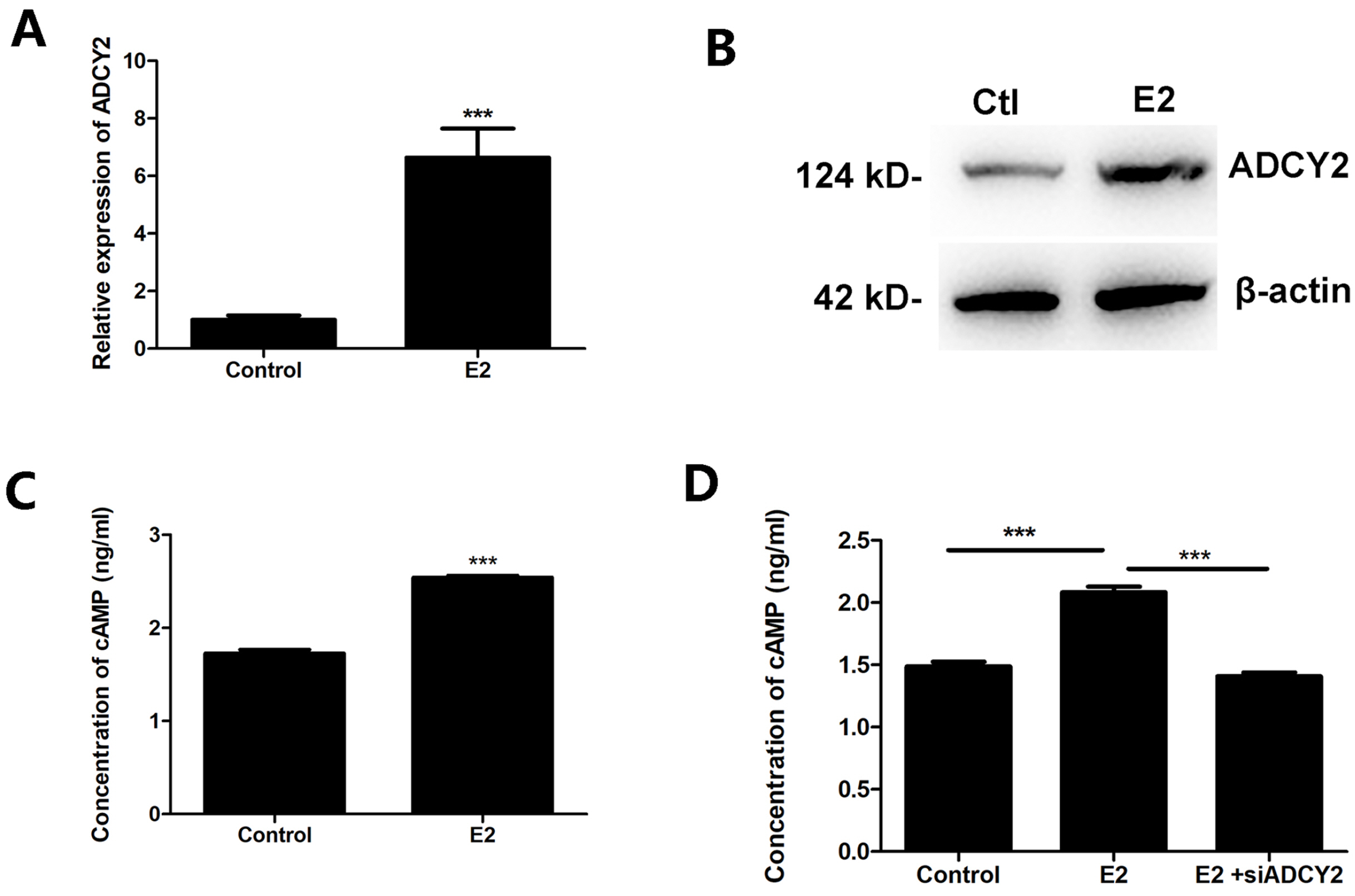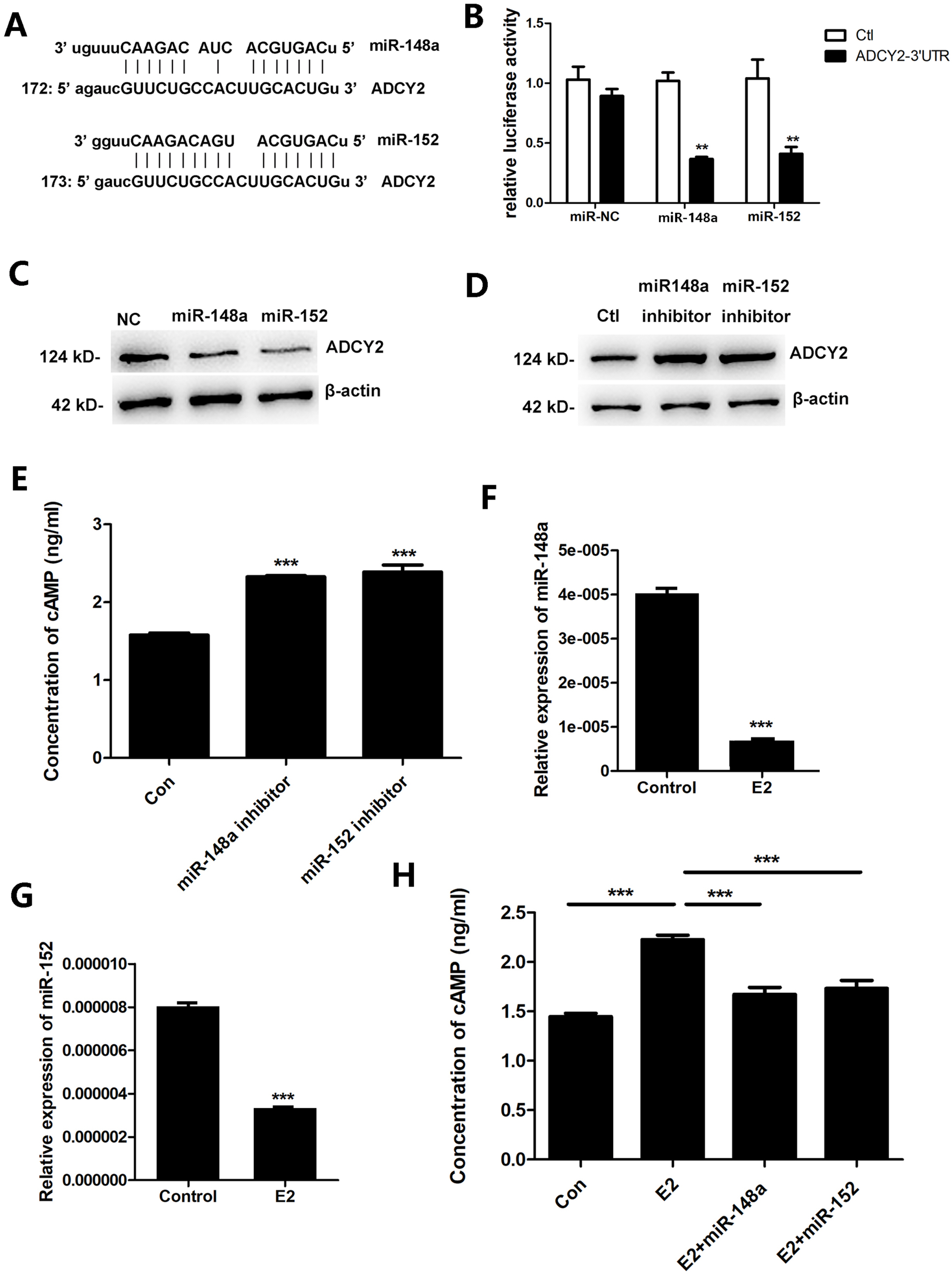Int J Stem Cells.
2020 Mar;13(1):55-64. 10.15283/ijsc19139.
Estrogen Promotes cAMP Production in Mesenchymal Stem Cells by Regulating ADCY2
- Affiliations
-
- 1Department of Obstetrics and Gynecology, Nanjing Drum Tower Hospital, Nanjing University Medical School, Nanjing, China
- 2The State Key Laboratory of Pharmaceutical Biotechnology, Division of Immunology, Medical School, Nanjing University, Nanjing, China
- KMID: 2500566
- DOI: http://doi.org/10.15283/ijsc19139
Abstract
- Background and Objectives
The maternal-fetal interface is an important source of mesenchymal stem cells (MSCs), and it is influenced by high levels of estradiol (E2) during pregnancy. It is highly important to study the role of E2 in MSCs for both clinical application and understanding of the mechanisms underlying pregnancy related diseases.
Methods and Results
In this study, differently expressed genes (DEGs) were found in the MSCs after exposure to E2. Then, Gene Ontology (GO) and Kyoto Encyclopedia of Genes and Genomes (KEGG) pathway enrichment analysis of DEGs was performed and the integrated regulatory network of DEGs-miRNA was constructed. A total of 390 DEGs were found in the MSCs exposed to E2, including 164 upregulated DEGs (e.g. ADCY2, VEGFA and PPY) and 226 downregulated DEGs (e.g. KNG1, AGT and NPY). Additionally, 10 miRNAs (such as miR-148A/B, miR-152, miR-182) identified the integrated regulatory network of DEGs-miRNAs. Among them, the expression of ADCY2 was significantly upregulated, and this was associated with multiple changed genes. We confirmed that the expression of ADCY2 is significantly promoted by E2 and subsequently promoted the production of cAMP in MSCs. We also found that E2 promoted ADCY2 expression by inhibiting miR-152 and miR-148a.
Conclusions
E2 promotes the expression of cAMP through miR-148a/152-ADCY2 in MSCs. It is suggested that E2 plays a key role in the growth and function of MSCs.
Keyword
Figure
Reference
-
References
1. Karahuseyinoglu S, Cinar O, Kilic E, Kara F, Akay GG, Demiralp DO, Tukun A, Uckan D, Can A. 2007; Biology of stem cells in human umbilical cord stroma: in situ and in vitro surveys. Stem Cells. 25:319–331. DOI: 10.1634/stemcells.2006-0286. PMID: 17053211.
Article2. Liu L, Zhao X, Li P, Zhao G, Wang Y, Hu Y, Hou Y. 2012; A novel way to isolate MSCs from umbilical cords. Eur J Immunol. 42:2190–2193. DOI: 10.1002/eji.201142356. PMID: 22585466.
Article3. Bianco P, Cao X, Frenette PS, Mao JJ, Robey PG, Simmons PJ, Wang CY. 2013; The meaning, the sense and the significance: translating the science of mesenchymal stem cells into medicine. Nat Med. 19:35–42. DOI: 10.1038/nm.3028. PMID: 23296015. PMCID: PMC3998103.
Article4. Zhao G, Zhou X, Chen S, Miao H, Fan H, Wang Z, Hu Y, Hou Y. 2014; Differential expression of microRNAs in decidua-derived mesenchymal stem cells from patients with pre-eclampsia. J Biomed Sci. 21:81. DOI: 10.1186/s12929-014-0081-3. PMID: 25135655. PMCID: PMC4237795.
Article5. Cutler AJ, Limbani V, Girdlestone J, Navarrete CV. 2010; Umbilical cord-derived mesenchymal stromal cells modulate monocyte function to suppress T cell proliferation. J Immunol. 185:6617–6623. DOI: 10.4049/jimmunol.1002239. PMID: 20980628.
Article6. Yen BL, Huang HI, Chien CC, Jui HY, Ko BS, Yao M, Shun CT, Yen ML, Lee MC, Chen YC. 2005; Isolation of multipotent cells from human term placenta. Stem Cells. 23:3–9. DOI: 10.1634/stemcells.2004-0098. PMID: 15625118.
Article7. Berkane N, Liere P, Oudinet JP, Hertig A, Lefèvre G, Pluchino N, Schumacher M, Chabbert-Buffet N. 2017; From pregnancy to preeclampsia: a key role for estrogens. Endocr Rev. 38:123–144. DOI: 10.1210/er.2016-1065. PMID: 28323944.
Article8. Wan J, Hu Z, Zeng K, Yin Y, Zhao M, Chen M, Chen Q. 2018; The reduction in circulating levels of estrogen and progesterone in women with preeclampsia. Pregnancy Hypertens. 11:18–25. DOI: 10.1016/j.preghy.2017.12.003. PMID: 29523268.
Article9. Jobe SO, Tyler CT, Magness RR. 2013; Aberrant synthesis, metabolism, and plasma accumulation of circulating estrogens and estrogen metabolites in preeclampsia implications for vascular dysfunction. Hypertension. 61:480–487. DOI: 10.1161/HYPERTENSIONAHA.111.201624. PMID: 23319542. PMCID: PMC3674508.
Article10. Li X, Song Y, Liu D, Zhao J, Xu J, Ren J, Hu Y, Wang Z, Hou Y, Zhao G. 2017; MiR-495 promotes senescence of mesenchymal stem cells by targeting Bmi-1. Cell Physiol Biochem. 42:780–796. DOI: 10.1159/000478069. PMID: 28628915.
Article11. Li X, Song Y, Liu F, Liu D, Miao H, Ren J, Xu J, Ding L, Hu Y, Wang Z, Hou Y, Zhao G. 2017; Long non-coding RNA MALAT1 promotes proliferation, angiogenesis, and immunosuppressive properties of mesenchymal stem cells by inducing VEGF and IDO. J Cell Biochem. 118:2780–2791. DOI: 10.1002/jcb.25927. PMID: 28176360.
Article12. Liu L, Zhao G, Fan H, Zhao X, Li P, Wang Z, Hu Y, Hou Y. 2014; Mesenchymal stem cells ameliorate Th1-induced pre-eclampsia-like symptoms in mice via the suppression of TNF-α expression. PLoS One. 9:e88036. DOI: 10.1371/journal.pone.0088036. PMID: 24558374. PMCID: PMC3928118.13. Zhao G, Miao H, Li X, Chen S, Hu Y, Wang Z, Hou Y. 2016; TGF-β3-induced miR-494 inhibits macrophage polarization via suppressing PGE2 secretion in mesenchymal stem cells. FEBS Lett. 590:1602–1613. DOI: 10.1002/1873-3468.12200. PMID: 27149081.
Article14. Smyth GK, Ritchie M, Thorne N, Wettenhall J. Gentleman R, Carey V, Huber W, editors. 2005. Limma: linear models for microarray data. Bioinformatics and Computational Biology Solutions Using R and Bioconductor: Statistics for Biology and Health. Springer;New York:
Article15. Tang Y, Li M, Wang J, Pan Y, Wu FX. 2015; CytoNCA: a cytoscape plugin for centrality analysis and evaluation of protein interaction networks. Biosystems. 127:67–72. DOI: 10.1016/j.biosystems.2014.11.005. PMID: 25451770.
Article16. Opsahl T, Agneessens F, Skvoretz J. 2010; Node centrality in weighted networks: generalizing degree and shortest paths. Soc Netw. 32:245–251. DOI: 10.1016/j.socnet.2010.03.006.
Article17. Cukierski WJ, Foran DJ. 2008; Using betweenness centrality to identify manifold shortcuts. Proc IEEE Int Conf Data Min. 2008:949–958. DOI: 10.1109/ICDMW.2008.39. PMID: 20607142. PMCID: PMC2895570.
Article18. Du Y, Gao C, Chen X, Hu Y, Sadiq R, Deng Y. 2015; A new closeness centrality measure via effective distance in complex networks. Chaos: Interdiscip J Nonlinear Sci. 25:033112. DOI: 10.1063/1.4916215. PMID: 25833434.
Article19. Bader GD, Hogue CW. 2003; An automated method for finding molecular complexes in large protein interaction networks. BMC Bioinformatics. 4:2. DOI: 10.1186/1471-2105-4-2. PMID: 12525261. PMCID: PMC149346.20. Yu Q, Peng C, Ye Z, Tang Z, Li S, Xiao L, Liu S, Yang Y, Zhao M, Zhang Y, Lin H. 2019; An estradiol-17β/miRNA-26a/cyp19a1a regulatory feedback loop in the protogynous hermaphroditic fish, Epinephelus coioides. Mol Cell Endocrinol. [Epub ahead of print]. DOI: 10.1016/j.mce.2019.110689. PMID: 31891771.21. Pérez-Cremades D, Mompeón A, Vidal-Gómez X, Hermenegildo C, Novella S. 2018; miRNA as a new regulatory mechanism of estrogen vascular action. Int J Mol Sci. 19:E473. DOI: 10.3390/ijms19020473. PMID: 29415433. PMCID: PMC5855695.
Article22. Liu G, Lu Y, Mai Z, Liu R, Peng Z, Chen L, Chen Z, Wang R, Ai H. 2019; Suppressing MicroRNA-30b by estrogen promotes osteogenesis in bone marrow mesenchymal stem cells. Stem Cells Int. 2019:7547506. DOI: 10.1155/2019/7547506. PMID: 31089333. PMCID: PMC6476012.
Article23. Sethna F, Feng W, Ding Q, Robison AJ, Feng Y, Wang H. 2017; Enhanced expression of ADCY1 underlies aberrant neuronal signalling and behaviour in a syndromic autism model. Nat Commun. 8:14359. DOI: 10.1038/ncomms14359. PMID: 28218269. PMCID: PMC5321753.
Article24. Shen JX, Cooper DM. 2013; AKAP79, PKC, PKA and PDE4 participate in a Gq-linked muscarinic receptor and adenylate cyclase 2 cAMP signalling complex. Biochem J. 455:47–56. DOI: 10.1042/BJ20130359. PMID: 23889134. PMCID: PMC3968274.
Article25. Gether U. 2000; Uncovering molecular mechanisms involved in activation of G protein-coupled receptors. Endocr Rev. 21:90–113. DOI: 10.1210/edrv.21.1.0390. PMID: 10696571.
Article26. Jekabsons K, Riekstina U, Parfejevs V, Laizane A, Pavasare M, Lencberga N, Jansone B, Muceniece R. 2011; Culture-expanded human dermal stem cells exhibit donor to donor differences in cAMP generation. Cell Tissue Res. 345:253–263. DOI: 10.1007/s00441-011-1203-9. PMID: 21698527.
Article27. Drucker DJ. 2003; Glucagon-like peptides: regulators of cell proliferation, differentiation, and apoptosis. Mol Endocrinol. 17:161–171. DOI: 10.1210/me.2002-0306. PMID: 12554744.
Article28. Yang DC, Tsay HJ, Lin SY, Chiou SH, Li MJ, Chang TJ, Hung SC. 2008; cAMP/PKA regulates osteogenesis, adipogenesis and ratio of RANKL/OPG mRNA expression in mesenchymal stem cells by suppressing leptin. PLoS One. 3:e1540. DOI: 10.1371/journal.pone.0001540. PMID: 18253488. PMCID: PMC2212109.
Article29. Siddappa R, Martens A, Doorn J, Leusink A, Olivo C, Licht R, van Rijn L, Gaspar C, Fodde R, Janssen F, van Blitterswijk C, de Boer J. 2008; cAMP/PKA pathway activation in human mesenchymal stem cells in vitro results in robust bone formation in vivo. Proc Natl Acad Sci U S A. 105:7281–7286. DOI: 10.1073/pnas.0711190105. PMID: 18490653. PMCID: PMC2387183.
Article30. Lu LL, Liu YJ, Yang SG, Zhao QJ, Wang X, Gong W, Han ZB, Xu ZS, Lu YX, Liu D, Chen ZZ, Han ZC. 2006; Isolation and characterization of human umbilical cord mesenchymal stem cells with hematopoiesis-supportive function and other potentials. Haematologica. 91:1017–1026. PMID: 16870554.31. Yang A, Zhang H, Sun Y, Wang Y, Yang X, Yang X, Zhang H, Guo W, Zhu G, Tian J, Jia Y, Jiang Y. 2016; Modulation of FABP4 hypomethylation by DNMT1 and its inverse interaction with miR-148a/152 in the placenta of preeclamptic rats and HTR-8 cells. Placenta. 46:49–62. DOI: 10.1016/j.placenta.2016.08.086. PMID: 27697222.
Article32. Zhang L, Yuan JM, Zhao RH, Wang LM, Tu ZB. 2019; Correlation of MiR-152 expression with VEGF expression in placental tissue of preeclampsia rat and its influence on apoptosis of trophoblast cells. Eur Rev Med Pharmacol Sci. 23:3553–3560. DOI: 10.26355/eurrev_201905_17776. PMID: 31114978.33. Li Q, Long A, Jiang L, Cai L, Xie LI, Gu J, Chen X, Tan L. 2015; Quantification of preeclampsia-related microRNAs in maternal serum. Biomed Rep. 3:792–796. DOI: 10.3892/br.2015.524. PMID: 26623017. PMCID: PMC4660598.
Article34. Shi C, Zhang M, Tong M, Yang L, Pang L, Chen L, Xu G, Chi X, Hong Q, Ni Y, Ji C, Guo X. 2015; miR-148a is associated with obesity and modulates adipocyte differentiation of mesenchymal stem cells through Wnt signaling. Sci Rep. 5:9930. DOI: 10.1038/srep09930. PMID: 26001136. PMCID: PMC4441322.
Article35. Jacenik D, Cygankiewicz AI, Fichna J, Mokrowiecka A, Małecka-Panas E, Krajewska WM. 2018; Estrogen signaling deregulation related with local immune response modulation in irritable bowel syndrome. Mol Cell Endocrinol. 471:89–96. DOI: 10.1016/j.mce.2017.07.036. PMID: 28774781.
Article36. He SZ, Li J, Bao HC, Wang MM, Wang XR, Huang X, Li FH, Zhang W, Xu AL, Fang HC, Sheng YX. 2018; G protein-coupled estrogen receptor/miR-148a/human leukocyte antigen-G signaling pathway mediates cell apoptosis of ovarian endometriosis. Mol Med Rep. 18:1141–1148. DOI: 10.3892/mmr.2018.9039. PMID: 29845209.
Article37. Rao ZZ, Zhang XW, Ding YL, Yang MY. 2017; miR-148a-mediated estrogen-induced cholestasis in intrahepatic cholestasis of pregnancy: Role of PXR/MRP3. PLoS One. 12:e0178702. DOI: 10.1371/journal.pone.0178702. PMID: 28575098. PMCID: PMC5457162.
Article38. Chen MJ, Cheng YM, Chen CC, Chen YC, Shen CJ. 2017; MiR-148a and miR-152 reduce tamoxifen resistance in ER+ breast cancer via downregulating ALCAM. Biochem Biophys Res Commun. 483:840–846. DOI: 10.1016/j.bbrc.2017.01.012. PMID: 28063929.
Article
- Full Text Links
- Actions
-
Cited
- CITED
-
- Close
- Share
- Similar articles
-
- Hormonal Regulation of Hematopoietic Stem Cells and Their Niche: A Focus on Estrogen
- Role of Gastric Stem Cells in Gastric Carcinogenesis by Chronic Helicobacter pylori Infection
- Role of Mesenchymal Stem Cells in Patients with Nontraumatic Osteonecrosis of the Femoral Head
- Nervonic Acid Inhibits Replicative Senescence of Human Wharton’s Jelly-Derived Mesenchymal Stem Cells
- Recent Trends and Strategies in Stem Cell Therapy for Alzheimer's Disease





